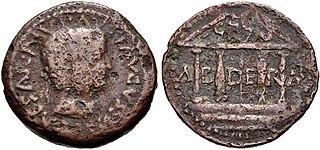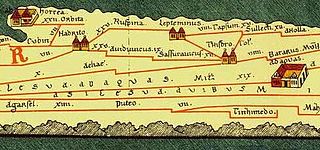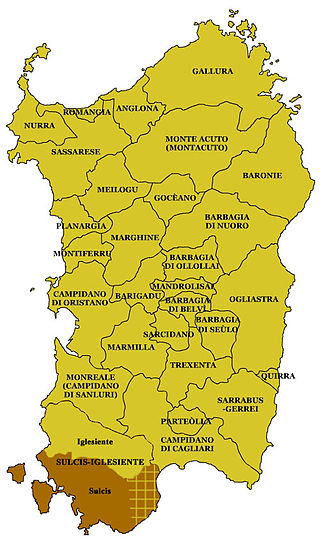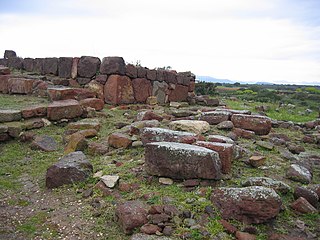
Abdera was an ancient Carthaginian and Roman port on a hill above the modern Adra on the southeastern Mediterranean coast of Spain. It was located between Malaca and Carthago Nova in the district inhabited by the Bastuli.

Sant'Antioco is the name of both an island and a municipality (comune) in southwestern Sardinia, in the Province of South Sardinia, in Sulcis zone. With a population of 11,730, the municipality of Sant'Antioco it is the island's largest community. It is also the site of ancient Sulci, considered the second city of Sardinia in antiquity.
Ruspina was a Phoenician, Carthaginian and Roman town located in Monastir, Tunisia, situated in Roman times in Africa propria, and mentioned by Pliny the Elder and Ptolemy.

The Province of Sardinia and Corsica was an ancient Roman province including the islands of Sardinia and Corsica.


The Punic religion, Carthaginian religion, or Western Phoenician religion in the western Mediterranean was a direct continuation of the Phoenician variety of the polytheistic ancient Canaanite religion. However, significant local differences developed over the centuries following the foundation of Carthage and other Punic communities elsewhere in North Africa, southern Spain, Sardinia, western Sicily, and Malta from the ninth century BC onward. After the conquest of these regions by the Roman Republic in the third and second centuries BC, Punic religious practices continued, surviving until the fourth century AD in some cases. As with most cultures of the ancient Mediterranean, Punic religion suffused their society and there was no stark distinction between religious and secular spheres. Sources on Punic religion are poor. There are no surviving literary sources and Punic religion is primarily reconstructed from inscriptions and archaeological evidence. An important sacred space in Punic religion appears to have been the large open air sanctuaries known as tophets in modern scholarship, in which urns containing the cremated bones of infants and animals were buried. There is a long-running scholarly debate about whether child sacrifice occurred at these locations, as suggested by Greco-Roman and biblical sources.

Montesarchio is a comune in the Province of Benevento, Campania, Southern Italy. It is located 18 kilometres southwest of Benevento in the Valle Caudina at the foot of Monte Taburno. The commune was granted the official status of city (città) by a presidential decree of 31 July 1977. In 2020, it had a population of 13,226. It is a member of the I Borghi più belli d'Italia association.

The Punic people, usually known as the Carthaginians, were a Semitic people who migrated from Phoenicia to the Western Mediterranean during the Early Iron Age. In modern scholarship, the term Punic, the Latin equivalent of the Greek-derived term Phoenician, is exclusively used to refer to Phoenicians in the western Mediterranean, following the line of the Greek East and Latin West. The largest Punic settlement was Ancient Carthage, but there were 300 other settlements along the North African coast from Leptis Magna in modern Libya to Mogador in southern Morocco, as well as western Sicily, southern Sardinia, the southern and eastern coasts of the Iberian Peninsula, Malta, and Ibiza. Their language, Punic, was a dialect of Phoenician, one of the Northwest Semitic languages originating in the Levant.

Leptis or Lepcis Parva was a Phoenician colony and Carthaginian and Roman port on Africa's Mediterranean coast, corresponding to the modern town Lemta, just south of Monastir, Tunisia. In antiquity, it was one of the wealthiest cities in the region.
Tibula, was an ancient town of Sardinia, near the northern extremity of the island, which appears to have been the customary landing-place for travelers coming from Corsica; for which reason the Itineraries give no less than four lines of route, taking their departure from Tibula as a starting-point.

Neapolis meaning "New City", was an ancient city of Sardinia founded by the Carthaginians in the sixth century BC, and apparently one of the most considerable places on that island. It was situated on the west coast, at the southern extremity of the Gulf of Oristano, at the present-day località of Santa Maria di Nabui, in the comune of Guspini, Province of Medio Campidano.

Sulcis is a subregion of Sardinia, Italy, in the Province of South Sardinia.

Rusadir was an ancient Punic and Roman town at what is now Melilla, Spain, in northwest Africa. Under the Roman Empire, it was a colony in the province of Mauretania Tingitana.

Ancient Carthage was an ancient Semitic civilisation based in North Africa. Initially a settlement in present-day Tunisia, it later became a city-state and then an empire. Founded by the Phoenicians in the ninth century BC, Carthage reached its height in the fourth century BC as one of the largest metropolises in the world. It was the centre of the Carthaginian Empire, a major power led by the Punic people who dominated the ancient western and central Mediterranean Sea. Following the Punic Wars, Carthage was destroyed by the Romans in 146 BC, who later rebuilt the city lavishly.
In several ancient Semitic-speaking cultures and associated historical regions, the shopheṭ or shofeṭ was a community leader of significant civic stature, often functioning as a chief magistrate with authority roughly equivalent to Roman consular powers.
This article presents a history of Cagliari, an Italian municipality and the capital city of the island of Sardinia. The city has been continuously inhabited since at least the neo-lithic period. Due to its strategic location in the Mediterranean and natural harbor, the city was prized and highly sought after by a number of Mediterranean empires and cultures.

The history of Corsica in ancient times was characterised by contests for control of the island among various foreign powers. The successors of the neolithic cultures of the island were able to maintain their distinctive traditions even into Roman times, despite the successive interventions of Etruscans, Carthaginians or Phoenicians, and Greeks. A long period of Roman rule was followed by renewed conflict for control of the island by the Vandals, Byzantines and Saracens.

Monte Sirai is an archaeological site near Carbonia, in the province of South Sardinia, Sardinia, Italy. It is a settlement built at the top of a hill by the Phoenicians of Sulci. The history of studies in Monte Sirai has a very precise date: the fall of 1962, when a local boy casually found a female figure carved on a stele of the tophet. Following further inspections, in August 1963, the local Soprintendenza and the Institute of Near Eastern Studies of the Sapienza University of Rome started excavations, leading to a fairly comprehensive study of the entire town.
Rusazus was a Phoenician, Carthaginian, and Roman town located near Cape Corbelin, Algeria. Its ruins are near the town of Azeffoun.

The history of Phoenician and Carthaginian Sardinia deals with two different historical periods between the 9th century BC and the 3rd century BC concerning the peaceful arrival on the island of the first Phoenician merchants and their integration into the Nuragic civilization by bringing new knowledge and technologies, and the subsequent Carthaginian presence aimed at exploiting mineral resources of the Iglesiente and controlling the fertile plains of the Campidano.



















